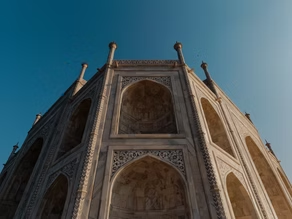A Complete Guide to the City of Mughal Marvels, Agra

Agra, a city in northern Uttar Pradesh has been the aristocratic residence of Mughals for many centuries. It is a city full of historical monuments, heritage, and architectural spectacles. Agra is dotted with square Persian styled gardens and magnificent structural design. Along with Delhi and Jaipur, it forms the golden tourism triangle of India and has been monumental in shaping Indian history. A visit to this majestic city is bound to feel like a roller coaster ride filled with anecdotes and legends of the bygone era, while the awe-striking monuments perfectly portray the glory of the mighty Mughal Empire. Agra is a perfect blend of modern and contemporary, while the beautiful establishments recite the grandeur of the past, the city is fully equipped with luxurious and state-of-the-art services for its visitors. While strolling through the bustling roads of this sumptuous city, you would discover that Agra is a place full of many hidden gems, and is not just confined to the colossal Mughal Architecture which makes it popular across the globe. The City of Agra, located in the Northern part of India How To Reach Agra: If you’re wondering how to reach Agra, don’t worry, we’ve got you covered. It is a highly commercialized city, has an airport which is situated at a distance of about 12.5 km from the main city, and 2 main railway stations as well. It is well connected with all the major cities of Northern India, and luxury trains like Palace on Wheels and Royal Rajasthan also have a stoppage in this city. It is connected to the national capital Delhi via NH2 and with Jaipur via NH11. It also has ample bus stops and is connected to many cities via the bus route. One of the beautiful railway stations of Agra, The Agra Fort Railway Station Must-Visit Destinations : If you are planning to visit the beautiful city of Agra, here are some of the places which should definitely not be skipped on your travel itinerary! 1. The Taj Mahal Agra is best known for the Taj Mahal, one of the most exquisite and bewitching spectacles of the world. No matter how many times you’ve been there, its intricate carvings and intoxicating beauty will always leave you mesmerized. It is one of the Seven Wonders of the World, and rightly so. With gemstones adorning its walls, intricate inlay work ornamenting its gables, and a strikingly symmetrical structure, the Taj is undoubtedly one of the finest edifices of Mughal architecture. This astonishing structure is unquestionably one of the best creations of the Mughal era, and what makes it even more extraordinary is the fact that it looks completely different at various times of the day. During the golden hours of dusk and dawn, it exhibits an elegant light pink shade, a dazzling white during the daytime, and a mesmerizing golden hue in the moonlight. Made entirely out of white marble, the majestic monument is a symbol of eternal love, and the mere sight of it is bound to leave you in poetic awe. The mighty Taj has also been referred to as a ‘teardrop on the cheek of eternity’, and with its intricate details, lustrous marble, and a structure tessellated with countless gems, it truly lives up to this lyrical expression. Even though Taj is undoubtedly one of the most impressive creations in the history of mankind, it is only one of the many memorable experiences that Agra has to offer. There are multiple other places that would take you to a journey of the past and would make you feel astonished and stupefied. Agra was a capital of the Mughal Empire for centuries and carries countless unheard tales and mysterious fables of the past to dwell upon. For more material to read on and understand the magnificent Taj, read Urban Travel Blog’s piece on The Taj Mahal and its beauty. Read SandeepaChetan‘s blog on photography tips for capturing the Taj for some great tips that you can use to take home memorable pictures of your trip to Agra. The mesmerizing Taj Mahal, laced with vivid hues 2. Fatehpur Sikri Located to the west of Agra and displaying excellent craftsmanship and compositional skills, is the stunning city of Fatehpur Sikri. This was one of the first cities to be fortified, and its walls contain numerous tacit and unheard historic secrets, waiting to be unraveled and deduced. There are many different buildings within the complex, each with their own significance. The style of architecture is strongly Islamic, with hints of Gujrati and Rajasthani styles peeking in here and there. The striking red sandstone is what gives this city a fascinating hue during the sunset, and is the primary material used to build this magnificent establishment. The city came to be known as Fatehpur Sikri, the “City of Victory”, after Akbar’s triumphant Gujarat campaign in 1573. This place comprises of a stunning mosque, and three palaces, one for each of his favorite wives – one a Hindu, one a Muslim and one a Christian. The grandeur of this deserted city cannot be explained in mere words, and the rich aura can only be experienced when you set foot in this imperial metropolis. One of the most developed cities of its time, Fatehpur Sikri is a true delight to witness 3. The Tomb Of Salim Chishti The Tomb of Salim Chishti is also termed as one of the most exquisite examples of Mughal architecture in India, built along with the imperial complex at Fatehpur Sikri. It preserves the burial place of the Sufi saint, Salim Chisi, who was worshipped and respected a lot by the people of his era. The main tomb building is encircled by delicate marble screens, and the tomb is located in the center of the main hall, which has a single semi-circular dome. The pedestal is ornamented with mosaics of black and yellow marble carved in

